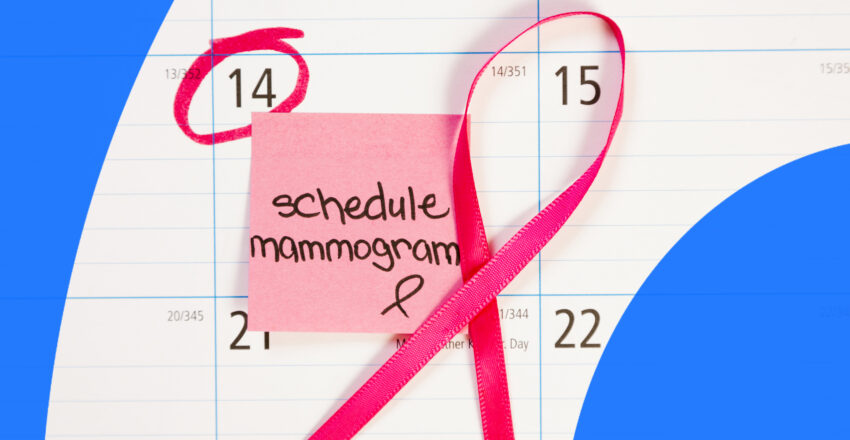Abdominal CT Scan with Contrast: What It Is and How It Works
February 29, 2024
Read More
During the peak of the pandemic, cancer diagnoses dropped almost in half and still have not rebounded to the pre-COVID-19 rates, according to one recent study. It may be why there’s more urgency around this Breast Cancer Awareness Month than previous years.
October is a reminder of the importance of staying on top of your health and scheduling that mammogram. This is necessary given that most preventative screenings were halted for a few months in 2020, during the height of COVID-19. When the restrictions were lifted, it took time for people to feel comfortable re-entering medical facilities. It also created a backlog of screening exams that radiology clinics are still digging out from.
Breast cancer screenings are important, though, and studies show that the delays are resulting in later cancer diagnoses. Those who aren’t diagnosed can’t be treated, and earlier treatment generally has a better prognosis and outcome.
Today, mammogram services are ramping up to meet demand, but finding an appointment at a nearby clinic can be challenging. Sometimes the next available appointment is several months out and with breast cancer, early detection saves lives. So, are you ready to schedule a mammogram? Here are some tips to getting your scan sooner rather than later.
Mobile Screening
You may have seen mobile screening buses or RVs around town. These vehicles hold the same mammography equipment found at imaging clinics and they are staffed with registered nurses and radiation technologists who perform mammograms on board. Screening buses were on the road even before the pandemic, typically traveling to remote communities, offering mammograms to those who need them. They were and still are effective at reaching underserved populations who may have difficulty getting to a clinic.
The mobile screening vehicles are sometimes at street fairs or grocery store parking lots. They sometimes visit community or senior centers, and some promote screenings for those with no health insurance.
While it may seem unconventional to get a mammogram on a bus, know that these machines are just as reliable and effective as the ones at your local hospital or doctor’s clinic. To find a mobile screening unit, include your city or region in the search engine. Some even offer walk-in hours without needing a doctor appointment, or have evening and weekend hours as well.
Family History
If you have a family history of breast cancer, it’s important to share this at the doctor’s visit. You could have a higher risk and the doctor may want you to get screenings at a younger age or more frequently than guidelines suggest for those with no known risk factors. If a family member had breast cancer, the doctor may want you to start screening a few years before their diagnosis age, but this is not a hard and fast rule. The doctor may also want more than one type of screening, like adding a diagnostic breast MRI to the mix. You might also want to get genetic screening to see if you have certain genetic mutations that could increase your likelihood of getting breast cancer.
Don’t Put It Off
It’s easy to avoid scheduling that doctor’s visit. Don’t procrastinate! Making the appointment should only take a few minutes and you’ll feel better once it’s on the calendar and delaying the scheduling just delays the whole process.
When you’re at a primary care doctor’s appointment, ask for the guidelines for how often you should get a mammogram. Then set a calendar reminder on your phone to make the appointment, even if it’s a year in advance. Some people like to schedule their mammogram around their birthday, so they remember to do something good for themselves. Or schedule an appointment at the same time as a friend and make it a date.
Once you have that appointment, do everything in your power to keep it. Time is key, because if there is a problem, treating it early can lead to better results.
Keep Your Mammogram Records in Order
We get it – it can be hard to track all your medical visits and results, even if there’s nothing wrong! Ruth does a great job at this. She keeps a spreadsheet with her appointment dates and results, so she has access to her medical history at a glance. While Ruth was diagnosed with breast cancer, this method can be used even with no diagnosis. Ruth signed up for PocketHealth, where she can easily access and share her imaging records with providers from a mobile device or computer.
Owning your health records and keeping them organized can help you – and your providers – better track your mammograms and other imaging studies over time. When you’re at your clinic appointment, you can share past mammogram links from PocketHealth with the radiologist, potentially saving you and the doctor time – and you may receive results faster. You can also store all your diagnostic imaging, not just mammograms, in an organized and secure system
Use this Breast Cancer Awareness Month as the reminder it’s supposed to be, by scheduling your mammogram if you haven’t already. Find a system that works for you, using some of the tips provided here, to own your health and take care of yourself. Regular screening tests like mammograms are the best way to detect breast cancer early. No one wants a cancer diagnosis, but early treatment can make a world of difference.
—
Be prepared for your next mammogram appointment with PocketHealth. Access your mammograms and other past imaging here.